Laser Cutting Machine Market Size
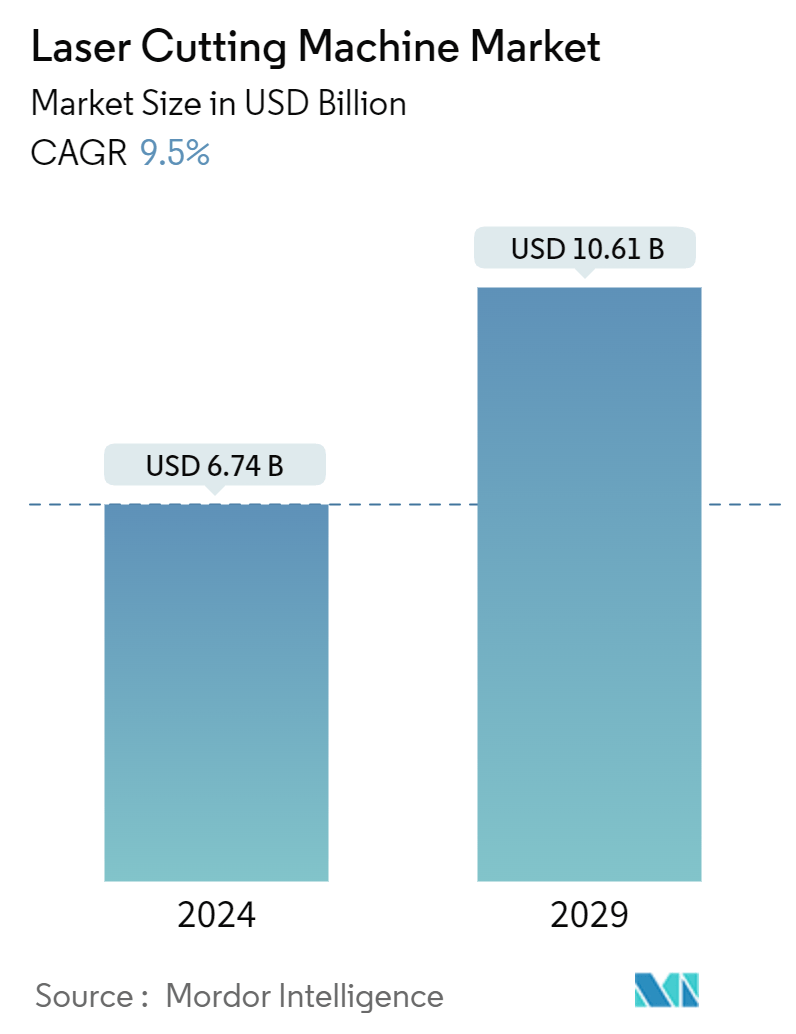
| Study Period | 2019 - 2029 |
| Market Size (2024) | USD 6.74 Billion |
| Market Size (2029) | USD 10.61 Billion |
| CAGR (2024 - 2029) | 9.50 % |
| Fastest Growing Market | Asia Pacific |
| Largest Market | Asia Pacific |
| Market Concentration | Medium |
Major Players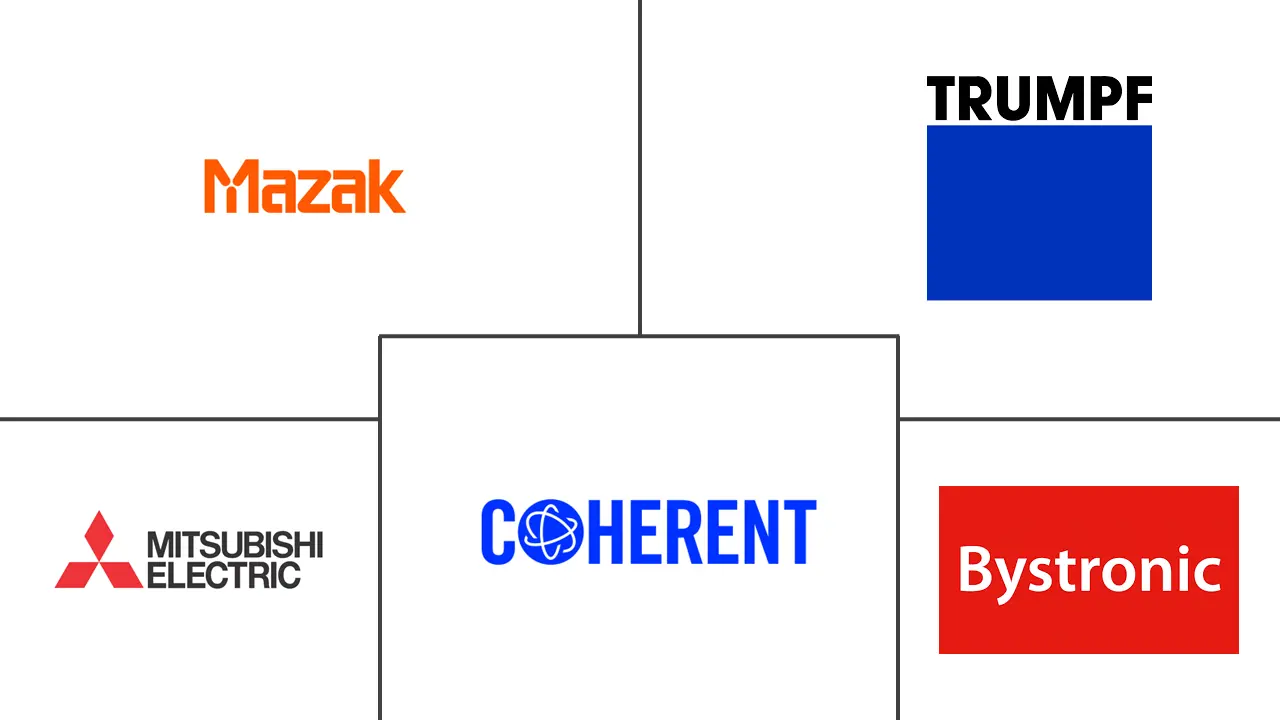
*Disclaimer: Major Players sorted in no particular order |
Laser Cutting Machine Market Analysis
The Laser Cutting Machine Market size is estimated at USD 6.74 billion in 2024, and is expected to reach USD 10.61 billion by 2029, at a CAGR of 9.5% during the forecast period (2024-2029).
- The laser-cutting machine market is driven by increased automation, technological advancement, and a growing focus on sustainability. Many manufacturers are integrating automation and robotics into laser cutting systems, improving efficiency and reducing labor costs. Laser-cutting technology is vital for manufacturing high-quality automotive parts due to its precision and speed. The process employs a concentrated laser beam to cut through materials with minimal waste, making it ideal for intricate designs and complex shapes. This capability is particularly crucial in the automotive sector, where even minor inaccuracies can lead to significant safety and performance issues.
- Manufacturers find fiber lasers and solid-state lasers increasingly attractive due to their ability to boost cutting speeds and lower operational costs. Modern manufacturing demands are increasingly met by new technologies that enhance material compatibility and efficiency.
- In the industrial sector, laser-cutting machines have emerged as indispensable tools, celebrated for their precision, efficiency, and versatility. These machines adeptly cut a variety of materials, including metal, plastic, wood, and glass, facilitating intricate designs and ensuring clean edges. Industries leverage laser cutting for rapid prototyping, which accelerates design iterations and shortens the time to market. Furthermore, in manufacturing, laser cutters play a pivotal role in mass-producing components, achieving high-speed cutting while minimizing waste.
- As part of their industrial growth, emerging markets are turning to laser-cutting technology, fueling demand, particularly in the Asia-Pacific and Europe regions. The increasing production of automotive and consumer electronics products in the region drives the market growth. For instance, Europe stands as a key player in the global automotive arena, contributing significantly to worldwide production units. Bolstered by governmental initiatives promoting electric vehicles, the region's laser-cutting machine market is poised for expansive growth. With an ambitious target, the European Union is set to slash CO2 emissions by 55% from 1990 benchmarks by 2030. Such initiatives are not only championing the adoption of EVs but are also propelling the market forward.
- Small and medium-sized enterprises (SMEs) often hesitate to adopt laser-cutting technology due to the high costs associated with purchasing and installing these machines. Additionally, ongoing expenses such as regular maintenance and consumables such as lenses and gases can strain budgets, raising concerns about long-term profitability. Furthermore, maximizing the potential of laser-cutting machines hinges on having skilled operators. A limited pool of trained personnel can hinder both adoption rates and operational efficiency.
- Rising inflation rates have increased the cost of products, raw materials, and services, including laser-cutting machines. Higher costs are leading to reduced purchasing power for consumers and businesses, slowing down market growth. Further, the ongoing war between Russia and Ukraine has disrupted the global supply chain, particularly affecting the availability and cost of raw materials used in laser-cutting machines. This is leading to delays in production and increased costs for manufacturers.
Laser Cutting Machine Market Trends
Automotive and Transportation is Expected to Grow with Significant CAGR
- Laser-cutting machines are pivotal in crafting intricate shapes from sheet metal, a necessity for contemporary automotive designs. This proficiency bolsters complex designs and elevates both aerodynamics and aesthetics. Leveraging laser technology, manufacturers can adeptly cut through both thin and thick metals, enabling versatility with materials ranging from steel and aluminum to high-strength alloys.
- With growing consumer demand for customized vehicles, laser cutting emerges as a cost-effective solution for swiftly producing tailored components, from custom grilles to badges—this technology crafts dashboard panels, trims, and decorative elements, offering unparalleled customization and design flexibility. Furthermore, laser cutting ensures precision in crafting materials for seating structures and covers, achieving an impeccable fit and finish.
- With increasing global demand, electric vehicle registrations have significantly risen in recent years, a trend expected to persist. According to the International Energy Agency (IEA), global registrations of new electric cars nearly reached 14 million in 2023, bringing the total number on the roads to 40 million. Further, in 2023, China held 16.1 million battery electric vehicle (BEV) stock 2023, which is more than 10 million compared to Europe in the same year.
- Numerous automotive manufacturers have seamlessly integrated laser-cutting machines into their automated production lines, boosting efficiency and slashing cycle times. Key vendors in the market are focusing on expansion and collaboration to gain market opportunities in the automotive industry.
- For instance, in September 2024, Siemens and Prima Power forged a partnership aimed at revolutionizing the automotive sector. Prima Power's Laser Next 1530/2130, the market's inaugural 3D laser cutting machine, proudly features Siemens' advanced SINUMERIK ONE. This alliance melds Siemens' state-of-the-art control and digitalization systems with Prima Power's four-decade expertise in automotive laser technology, setting unprecedented standards in vehicle manufacturing for productivity, efficiency, and integrability.
- Laser cutting extends its prowess beyond personal vehicles, playing a pivotal role in crafting parts for trains and aircraft. From structural elements to panels and brackets, the precision of laser cutting is paramount, ensuring safety and reliability in these vital applications. The growing bullet train or high-speed train projects in various countries across the globe create new market opportunities.
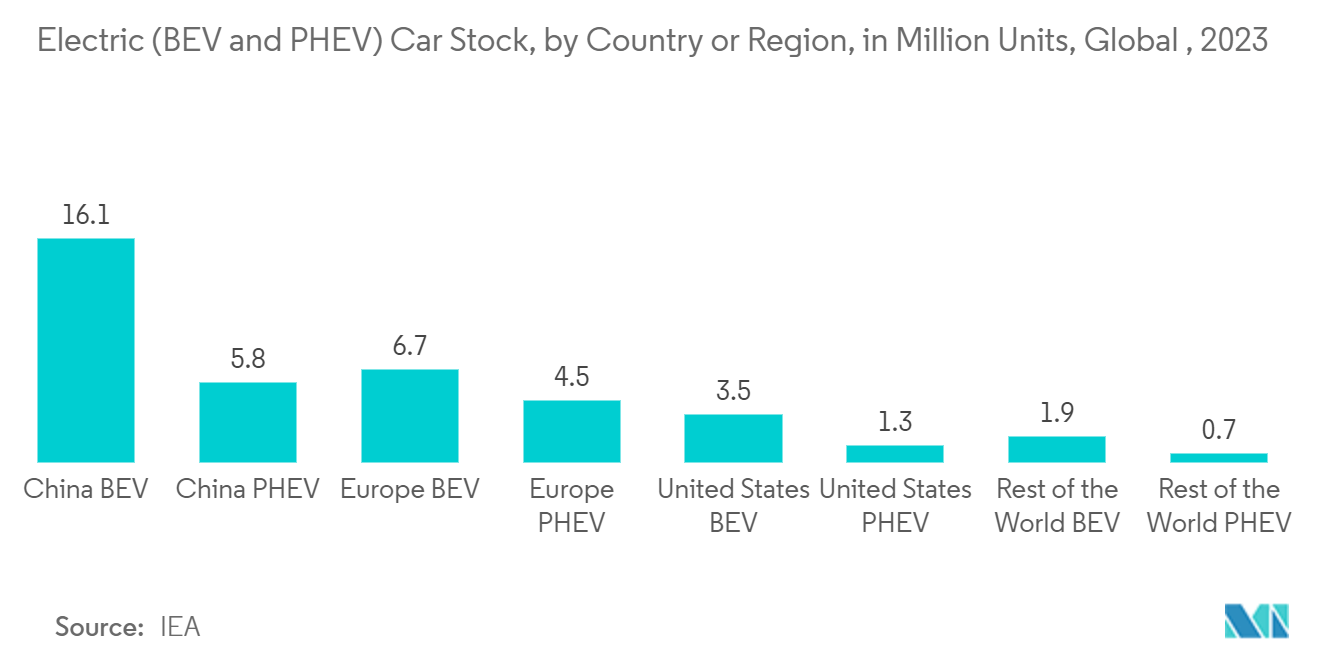
Asia Pacific to Register Major Growth
- Rapid industrialization, technological advancements, and a focus on customization and sustainability drive the demand for laser-cutting machines in Asia-Pacific. Government support through investment initiatives, skill development programs, regulatory simplification, and R&D incentives is crucial in fostering an environment conducive to market growth. As these trends continue, the Asia-Pacific region is likely to remain a significant player in the global laser cutting machine market.
- The Asia-Pacific region, particularly countries like China, India, and Vietnam, is experiencing rapid industrialization. This growth is driving an increased demand for efficient manufacturing processes, where laser-cutting machines provide precision and speed. Major investments in infrastructure projects are boosting demand for components that require laser-cutting technology. The shift towards automation and smart manufacturing practices is increasing the adoption of laser cutting systems integrated with robotics and AI.
- With the expansion of the aerospace sector in countries like India, there is a growing need for high-quality cutting solutions for various materials used in aircraft manufacturing. In April 2024, GE Aerospace announced a significant investment exceeding INR 240 crore (approximately USD 28.5 million) aimed at expanding and upgrading its manufacturing facility located in Pune. This investment will enable the Pune facility to introduce new projects and manufacturing processes. This will be achieved through the acquisition of advanced machines, specialized equipment, and tools, alongside enhancing the capacity of its existing product line. Such investments in the aerospace sector in India will create demand for laser-cutting machines to design aircraft parts and components.
- Governments across the Asia-Pacific region actively promote advanced manufacturing technologies, such as laser cutting. A prime example is India's "Make in India" initiative, which champions domestic manufacturing and innovation. Additionally, these governments are extending financial support, grants, and incentives to manufacturers who embrace advanced technologies, including laser-cutting machines.
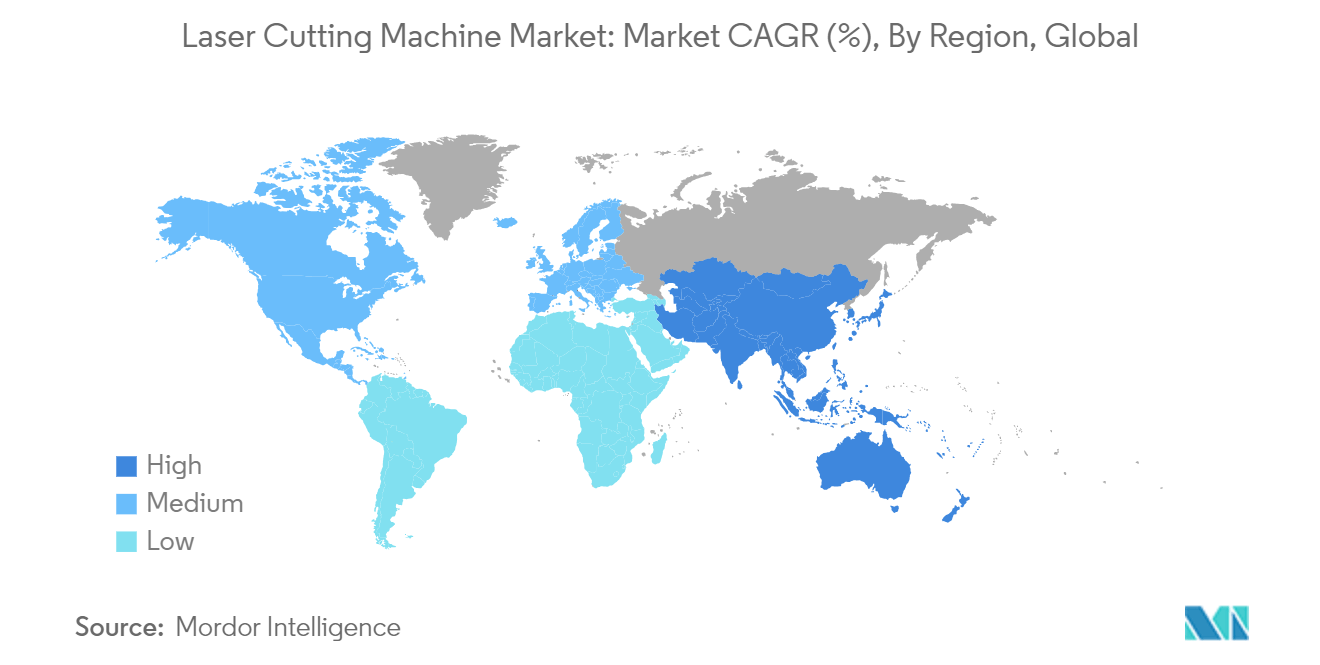
Laser Cutting Machine Industry Overview
The laser cutting machine market is moderately fragmented, with global and local conglomerates and specialized players operating across various segments. While several large multinational companies dominate specific high-value segments, numerous regional and niche players contribute to the overall competition, making the market highly diverse. This fragmentation is driven by the demand for laser-cutting machines across a wide range of end-user verticals, allowing both large and small companies to coexist and thrive in the market.
Leading companies in the laser cutting machine market include Trumpf, Bystronic Group, Yamazaki Mazak Corporation, Amada, Coherent Corp, IPG Photonics Corporation, Prima Industrie S.p.A., Mitsubishi Electric Corporation, Han's Laser Corporation, and Hypertherm, Inc. These companies have established strong brand recognition and extensive global operations, enabling them to command significant market share. Their strengths lie in innovation, broad product portfolios, and strong distribution networks. These leaders often engage in strategic acquisitions and partnerships to maintain their competitive edge and expand their market reach.
To succeed in the laser cutting machine market, companies must prioritize innovation, as demand from major industries such as aerospace, automotive, metal, and others is accelerating. In recent years, significant technological advancements have transformed the laser-cutting machine market. Companies that invest in emerging markets and adapt their offerings to regional needs are likely to gain a competitive advantage in this fragmented market.
Laser Cutting Machine Market Leaders
-
Yamazaki Mazak Corporation
-
Coherent Corp
-
Trumpf
-
Bystronic Group
-
Mitsubishi Electric Corporation
*Disclaimer: Major Players sorted in no particular order
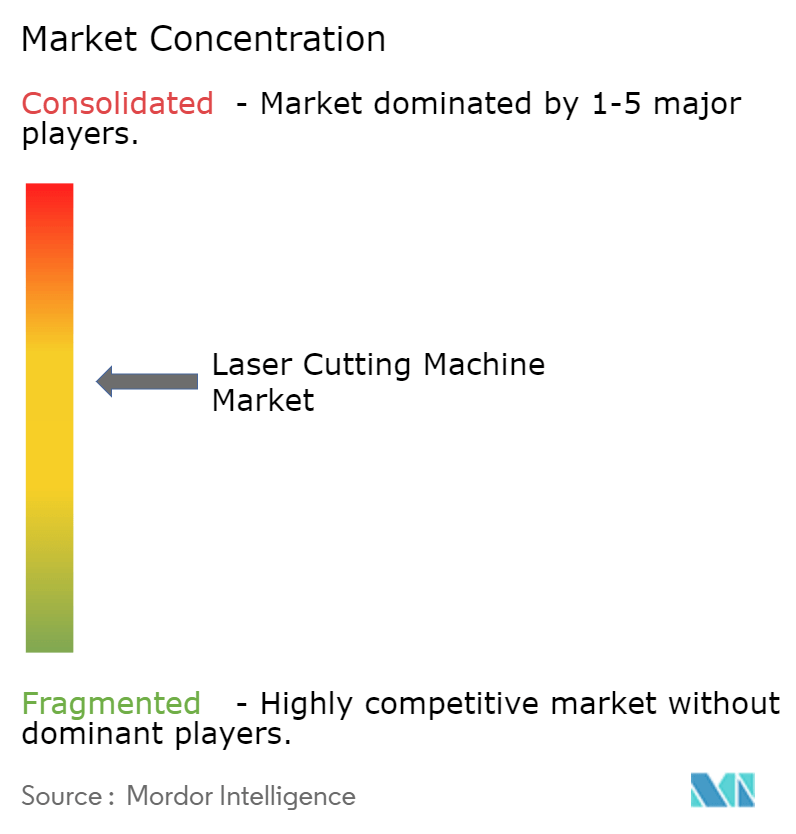
Laser Cutting Machine Market News
- October 2024: TRUMPF is set to unveil its latest laser cutting machine at EuroBLECH. This machine caters to customers with modest production volumes, prioritizing reliability while keeping investment and operating costs low. The TruLaser Series 1000 Lean Edition matches the quality standards of TRUMPF's premium models yet comes at a considerably reduced price point.
- August 2024: Bodor launched its latest innovation, the M series flagship fiber laser cutting machine. This state-of-the-art four-chuck laser machine boasts the groundbreaking Dual Process Parallel Processing capability, marking a significant leap in tube cutting technology. This advancement reaffirms Bodor's steadfast dedication to providing solutions that align with the dynamic demands of contemporary production settings.
Laser Cutting Machine Market Report - Table of Contents
1. INTRODUCTION
1.1 Study Assumptions and Market Definition
1.2 Scope of the Study
2. RESEARCH METHODOLOGY
3. EXECUTIVE SUMMARY
4. MARKET INSIGHTS
4.1 Market Overview
4.2 Industry Attractiveness - Porter's Five Forces Analysis
4.2.1 Threat of New Entrants
4.2.2 Bargaining Power of Buyers/Consumers
4.2.3 Bargaining Power of Suppliers
4.2.4 Threat of Substitute Products
4.2.5 Intensity of Competitive Rivalry
4.3 Impact of COVID-19 Aftereffects and Other Macroeconomic Factors on the Market
5. MARKET DYNAMICS
5.1 Market Drivers
5.1.1 Rising Demand for Electric Vehicles and Consumer Electronics
5.1.2 Increasing Adoption of Automation and Industry 4.0
5.2 Market Restraints
5.2.1 High Initial Costs
6. MARKET SEGMENTATION
6.1 By Technology
6.1.1 Gas-based
6.1.2 Solid State
6.1.3 Fiber-based
6.2 By End-user Industry
6.2.1 Consumer Electronics and Appliances
6.2.2 Automotive and Transportation
6.2.3 Industrial
6.2.4 Metal
6.2.5 Others
6.3 By Geography***
6.3.1 North America
6.3.2 Europe
6.3.3 Asia
6.3.4 Australia and New Zealand
6.3.5 Middle East and Africa
6.3.6 Latin America
7. COMPETITIVE LANDSCAPE
7.1 Company Profiles
7.1.1 Trumpf
7.1.2 Bystronic Group
7.1.3 Yamazaki Mazak Corporation
7.1.4 Amada
7.1.5 Coherent Corp
7.1.6 IPG Photonics Corporation
7.1.7 PRIMA INDUSTRIE S.p.A.,
7.1.8 Mitsubishi Electric Corporation
7.1.9 Han's Laser Corporation
7.1.10 Hypertherm, Inc.
- *List Not Exhaustive
8. INVESTMENT ANALYSIS
9. FUTURE OUTLOOK OF THE MARKET
Laser Cutting Machine Industry Segmentation
Laser cutting machines use high-powered laser beams to precisely cut or etch designs onto materials such as steel, plastic, and wood. These machines are used in industrial manufacturing, and the beam effectively burns, vaporizes, or melts away excess material, resulting in a superior finished design or edge.
The study tracks the revenue accrued through the sale of laser-cutting machines by various players across the globe. The study also tracks the key market parameters, underlying growth influencers, and major vendors operating in the industry, which supports the market estimations and growth rates over the forecast period. The study further analyses the overall impact of COVID-19 aftereffects and other macroeconomic factors on the market. The report’s scope encompasses market sizing and forecasts for the various market segments.
The laser cutting machine market is segmented by technology (gas-based, solid state, fiber-based), by end-user industry (consumer electronics and appliances, automotive and transportation, industrial, metal, others), and by geography (North America, Europe, Asia Pacific, Middle East & Africa, Latin America). The market sizes and forecasts regarding value (USD) for all the above segments are provided.
| By Technology | |
| Gas-based | |
| Solid State | |
| Fiber-based |
| By End-user Industry | |
| Consumer Electronics and Appliances | |
| Automotive and Transportation | |
| Industrial | |
| Metal | |
| Others |
| By Geography*** | |
| North America | |
| Europe | |
| Asia | |
| Australia and New Zealand | |
| Middle East and Africa | |
| Latin America |
Laser Cutting Machine Market Research FAQs
How big is the Laser Cutting Machine Market?
The Laser Cutting Machine Market size is expected to reach USD 6.74 billion in 2024 and grow at a CAGR of 9.5% to reach USD 10.61 billion by 2029.
What is the current Laser Cutting Machine Market size?
In 2024, the Laser Cutting Machine Market size is expected to reach USD 6.74 billion.
Who are the key players in Laser Cutting Machine Market?
Yamazaki Mazak Corporation, Coherent Corp, Trumpf, Bystronic Group and Mitsubishi Electric Corporation are the major companies operating in the Laser Cutting Machine Market.
Which is the fastest growing region in Laser Cutting Machine Market?
Asia Pacific is estimated to grow at the highest CAGR over the forecast period (2024-2029).
Which region has the biggest share in Laser Cutting Machine Market?
In 2024, the Asia Pacific accounts for the largest market share in Laser Cutting Machine Market.
What years does this Laser Cutting Machine Market cover, and what was the market size in 2023?
In 2023, the Laser Cutting Machine Market size was estimated at USD 6.10 billion. The report covers the Laser Cutting Machine Market historical market size for years: 2019, 2020, 2021, 2022 and 2023. The report also forecasts the Laser Cutting Machine Market size for years: 2024, 2025, 2026, 2027, 2028 and 2029.
Laser Cutting Machine Industry Report
Statistics for the 2024 Laser Cutting Machine market share, size and revenue growth rate, created by Mordor Intelligence™ Industry Reports. Laser Cutting Machine analysis includes a market forecast outlook for 2024 to 2029 and historical overview. Get a sample of this industry analysis as a free report PDF download.



